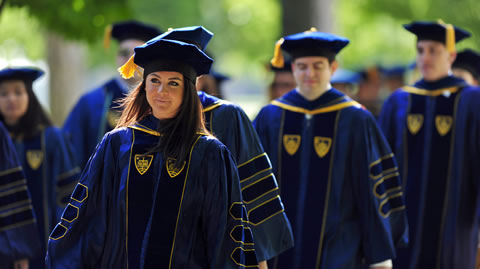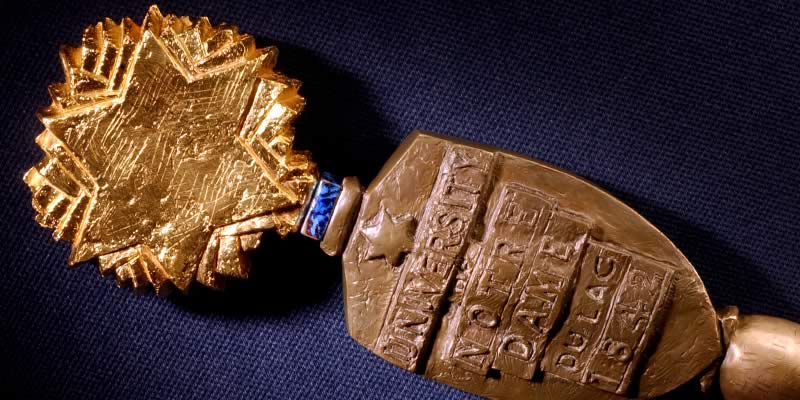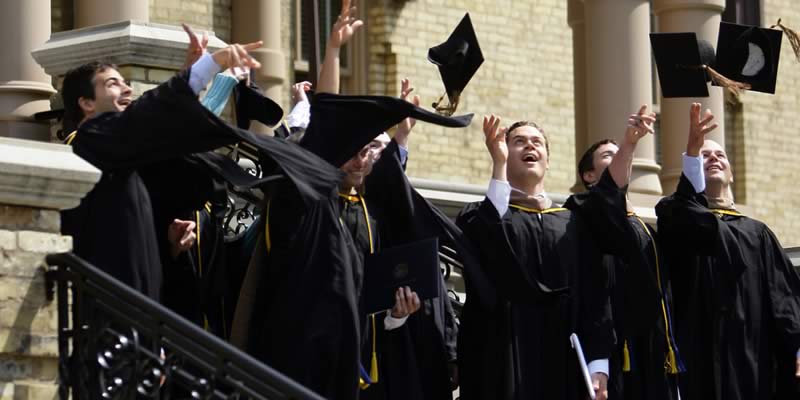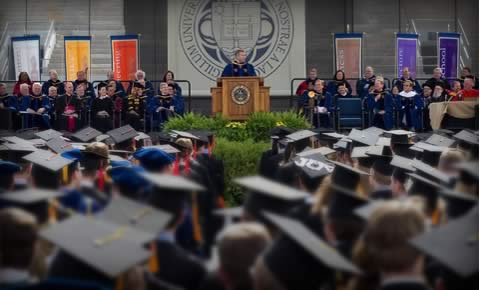The University of Notre Dame celebrated its first commencement ceremony of sorts in 1844, just two years after French priest Edward F. Sorin began the work of transforming a small log chapel-cabin combination into a college. There were no degrees to present, but certificates and awards were distributed.
In 1849, the University’s first proper commencement took place with two candidates receiving the degree of Bachelor of Arts and Letters. Neal Gillespie and Richard Shortis were Notre Dame’s first graduates. The six-hour ceremony included speeches by the two graduates and by some of the younger students, followed by the performance of two plays with a band providing entertainment during intermissions.
Since these humble beginnings, Notre Dame's commencement ceremony has included addresses by Mother Teresa, seven U.S. Presidents, and many other world leaders and celebrities calling upon graduates to go forth and do good. This year's 167th Commencement Ceremony on Sunday, May 20, will recognize nearly 3,000 undergraduate and graduate degree recipients.
Academic Attire

Ceremonial garments worn at academic functions take their meaning from the original centers of learning of the Western world in the Church of the Middle Ages. The caps, hoods, and gowns of these students and monks have been held through the centuries to be traditionally symbolic of the scholarly devotion so basic to education and to the deliberate and orderly evolution of knowledge.
Measures were taken to signify through distinctive markings on the academician’s attire the institution that had granted the degree, the field of learning in which the degree has been earned, and the level of the degree—bachelor, master, or doctorate.

At Notre Dame, individuals receiving bachelor’s degrees do not wear hoods. A master’s degree recipient wears a hood three-and-a-half feet in length with a three-inch wide border, and is slit at the bottom. Those individuals with a doctoral degree wear a hood four feet in length, open at the bottom, with a five-inch border.
The gown is usually black in color, but some American universities, including Notre Dame, have adopted distinctive colors for their robes. Notre Dame doctoral degree robes are blue, reflecting one of its official colors, and have royal blue velvet front panels with the University’s shield embroidered in gold. The royal blue sleeve chevrons are outlined in gold.
Notre Dame’s doctoral cap is a royal blue tam. Colored tassels denoting a field of learning are usually worn by holders of the bachelor’s and master’s degrees. Gold tassels are reserved for those individuals with doctoral degrees and for governing officers of educational institutions. Tassels are worn on the right side and shifted to the left after the degree has been conferred. Learn more.
The Mace and Medal

The academic scepter, or mace, was one of the earliest distinctive signs of medieval university officials. The mace was originally a wooden staff carried by royal messengers. The bronze caput repeats the University seal found on the Presidential Medal, but brings the star outside the shield to emphasize the patronage of the Virgin Mary. Its shaft is in walnut, and the star and the finial bear the University colors of gold and blue.

The tradition of a mace bearer and a Presidential Medal was introduced at the inauguration of Notre Dame’s 16th President, Rev. Edward A. Malloy, C.S.C. Each year a new mace bearer is selected, representing a different college or school. The medal is worn by the President of the University during Commencement Ceremonies.
The seal of the University forms the center of the medal and is mounted in relief against a larger cross representative of the Congregation of Holy Cross. At the base of the shield are two waves which symbolize St. Mary’s Lake on whose shores the University was founded. In the upper left, the six-pointed star, considered the perfect form, signifies the “Star of the Sea,” a title accorded the Virgin Mary, for whom Notre Dame is named. A cross symbolizes Christianity. The open book, emblematic of education, is inscribed with the Latin words, Vita, Dulcedo, Spes, or “our Life, our Sweetness, and our Hope.” These words, first addressed to Our Lady by Saint Bernard, are taken from the familiar prayer, Salve Regina, or “Hail Holy Queen.”
Processional Banners

The gonfalon, a banner that hangs from a crosspiece or frame, originated in the medieval republics of Italy as an ensign of state or office. The nine gonfalons represent the University of Notre Dame and its eight colleges and schools. By tradition, faculty marshals carry the gonfalons during the academic procession.
The lower half of the gonfalon consists of a shield with a clear blue field and a cross of gold. The heraldic colors (gold and blue) are symbolic of the Mother of God, to whom Father Sorin first dedicated Notre Dame. At the shield’s base are two wavy lines (indicating a Lacu, “of the Lake” in the University’s official title), and above them to the left is a star, another emblem of the Virgin, “Star of the Sea.” The cross represents the Congregation of Holy Cross, which founded Notre Dame; an institution of learning is denoted by the open book. The phrase Vita, Dulcedo, Spes, taken from the ancient prayer to the Virgin, the Salve Regina, celebrates her as “Life, Sweetness, and Hope.”
Steps of the Main Building

The outside front steps leading to the second floor of the Main Building cannot be used by students until after they graduate. This tradition dates back to Father Sorin, when only faculty were allowed to use the steps.
On commencement weekend, for the first time a student would walk down the front steps of the Main Building, first to Sacred Heart Basilica and later down the steps again en route to graduation. The tradition of the steps being off limits until commencement originates in 19th-century porch etiquette and smoking rituals. Only after successful completion of a degree program was a student deemed equal enough to ascend the steps and to smoke on the porch with his professors.
Architecture Caps

Students graduating from the School of Architecture construct an impressive assortment of model buildings, bridges, monuments, ferris wheels, skyscrapers, parks, etc., and attach them to the top of their caps to display during graduation.
Needless to say, the architecture seating assignment during the University Commencement Ceremony is located in the back rows of the main floor section.
